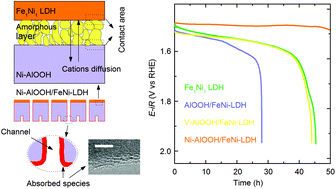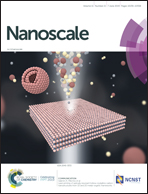In situ growth of layered double hydroxides on boehmite AlOOH for active and stable oxygen evolution in alkaline media†
Abstract
Among all the non-precious electrocatalysts for the oxygen evolution reaction (OER), FeNi and FeCo layered double hydroxides (LDHs) display the best activity. However, due to the unavoidable transformation of the active M3+/4+ (M = Fe, Co, and Ni) ions into inert M–O–H species, their activity dramatically decreases after about 25 h during stability tests, which means the widely-adopted stability test with a duration of 24 h is not sufficient for LDHs. Herein, the in situ growth of Fe1Co1 and Fe1Ni1 LDH nanosheets on V- and Ni-doped AlOOH nanorods was extended for the duration of stable electrocatalysis to 50 h. The V and Ni dopants were found to promote the diffusion of active Fe, Co and Ni cations along the abundant {100} planes of AlOOH single-crystalline nanorods with their {100} family of crystal planes perpendicular to the lateral facet, avoiding the aggregation of the active species and their transformation into inert species and their following nucleation and growth. Besides, the nano-channels on the nanorods generated during the subsequent in situ growth of LDHs are beneficial for the supply of OH− and the transportation of O2, which enhance the activity and stability of these composites.



 Please wait while we load your content...
Please wait while we load your content...